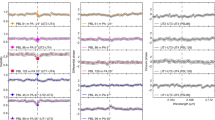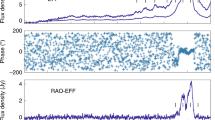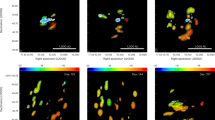Abstract
CERTAIN hot stars, belonging to the Be class, may have an envelope of hydrogen gas, possibly in the form of a rotating disk1 or spheroidal shell2. Other models involve elliptical rings3 or close binary systems where the Roche lobe of the companion is filled with hydrogen2. The angular size of these features is too small for direct detection by conventional telescopes, and attempts to resolve the structure using speckle interferometry (a technique that restores the diffraction-limited resolution otherwise degraded or spoiled by the atmosphere) have failed. The various models of the structure of the hydrogen envelope are based on spectroscopic data, together with polarization and variability measurements. After a century of spectroscopic observations, which showed considerable but little-understood variations, the hydrogen envelope of the star gamma Cassiopeiae was angularly resolved by the prototype interferometer I2T in 1986 (ref. 4). Here we report observations from its successor GI2T, which show further high-resolution details of the hydrogen envelope. The data clearly show the envelope in rotation and approximately fit a disk model. Thus, the GI2T yields optical information capable of constraining astrophysical models on a milliarcsecond scale.
This is a preview of subscription content, access via your institution
Access options
Subscribe to this journal
Receive 51 print issues and online access
$199.00 per year
only $3.90 per issue
Buy this article
- Purchase on Springer Link
- Instant access to full article PDF
Prices may be subject to local taxes which are calculated during checkout
Similar content being viewed by others
References
Poeckert, R. & Malborough, J. M. Astrophys. J. 220, 940–961 (1978).
Underhill, A. & Doazan, V. B Stars With and Without Emission Lines, NASA Report SP-456 (1982).
Huang, S. S. Astrophys. J. 219, 956 (1978).
Thom, C., Granes, P. & Vakili, F. Astr. Astrophys. 165, L13–L15 (1986).
Labeyrie, A. et al. Astr. Astrophys. 162, 359–364 (1986).
Bosc, I. thesis, Univ. Nice (1989).
Mourard, D. Proc. Coll. High-Resolution Imaging by Interferometry (ed. Merkle, F.) (European Southern Observatory, Garching, 1988).
Blazit, A. Proc. Coll. Soc. Franc. Opt. Image Detection and Quality, Soc. Photogr. Instrementation Engrs 702, 259–263 (1986).
Labeyrie, A. et al. Proc. Coll. High-Resolution Imaging by Interferometry (ed. Merkle, F.).
Proposal for construction of the 16-m Very Large Telescope (European Southern Observatory, Garching, 1987).
Labeyrie, A. Proc. NATO Advanced Study Institute (eds Alloin, D. M. & Mariotti, J. M.) 327–339 (Kluwer, Dordrecht, 1989).
Labeyrie, A. Proc. Kitt Peak Natn. Observ. Conf. Optical and Infrared Telescopes for the 1990s (ed. Hewitt, A.) 786–796 (Tuscon, 1980).
Petrov, R. Proc. NATO Adv. Study Inst. (eds Alloin, D. M. & Mariotti, J. M.) 243–271 (Kluwer, Dordrecht, 1989).
Labeyrie, A. Astr. Astrophys. 6, 85–87 (1970).
Roddier, F. Phys. Rep. 170, 97–166 (1988).
Thorn, C. thesis, Univ. Nice (1986).
Poeckert, R. & Marlborough, J. M. Astrophys. J. 206, 182–195 (1976).
Author information
Authors and Affiliations
Rights and permissions
About this article
Cite this article
Mourard, D., Bosc, I., Labeyrie, A. et al. The rotating envelope of the hot star gamma Cassiopeiae resolved by optical interferometry. Nature 342, 520–522 (1989). https://doi.org/10.1038/342520a0
Received:
Accepted:
Issue Date:
DOI: https://doi.org/10.1038/342520a0
This article is cited by
-
High-resolution imaging for advances in astronomy
Journal of Optics (2021)
-
Fizeau Mask Interferometry of Solar Features Using the Multi-application Solar Telescope at the Udaipur Solar Observatory
Solar Physics (2020)
-
Perspectives of a visible instrument on the VLTI
Experimental Astronomy (2018)
-
Speckle Interferometric Technique for Astronomical Observations
Journal of Optics (2003)
Comments
By submitting a comment you agree to abide by our Terms and Community Guidelines. If you find something abusive or that does not comply with our terms or guidelines please flag it as inappropriate.



